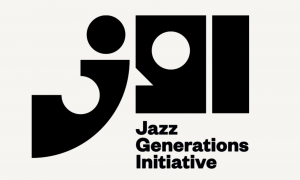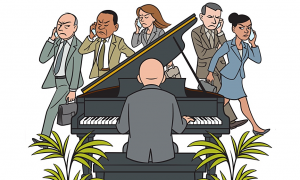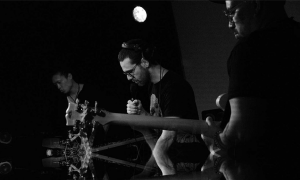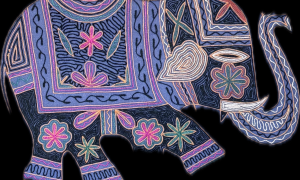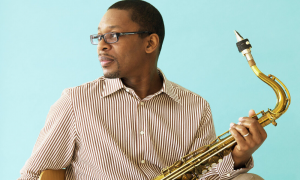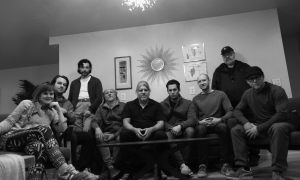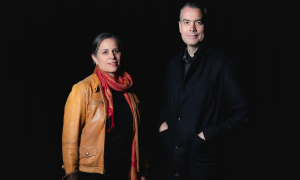
Having spent the day yesterday listening to Cab Calloway's recordings from 1930 to 1955, I began to wonder: Has Calloway been shortchanged? Does hip start with his records of the early '30s? Did he originate cool? Can jazz's with-it, knowing wink be traced back to his records of the early '30s? Calloway, of course, was the baton-waving bandleader with the tuxedo suits and tails, wide-brim hats, oversized mouth, unkempt hair and songs about Minnie the Moocher and Hi-De-Ho—all celebrated perfectly in the early cartoons of Max Fleischer. Sketches, a new documentary on Calloway by filmmaker Gail Levin, nibbles on this thought. It will air for the first time on Monday, February 7 at 9 p.m. on WLIW in New York. More on the documentary in a moment.
The natural followup questions are these: Was Calloway an exponent of the jazz scene that preceded him? Or was he an original, creating a new, intoxicating free-style approach complete with hipster lingo? If the answer is the latter, did jazz musicians who followed Calloway have his wildman persona in mind as they worked to build a following? Could Louis Prima, Lionel Hampton, Dizzy Gillespie [pictured], Frankie Laine, Little Richard, Jerry Lee Lewis, James Brown and even Prince really have been possible without Calloway's expressive and extravagant approach to music and performance?
Calloway certainly was the first popular singer and bandleader to capture the imaginations of millions of blacks who had migrated from the rural South to the urban North and West. While Duke Ellington was revered by this audience in heroic terms, his status was fed by awe. Ellington in the '30s was as admired for his grace and powerful orchestral music as he was for his enormous success navigating the choppy waters of white management, radio and record companies without compromising the authenticity of his art or Harlem roots.
Calloway was slightly different. He was street. He was a singer, dancer and flamboyant showman. And his personal pandemonium, twirling steps and exaggerated manner of dress were instantly recognizable to urban blacks as a collage of neighborhood prototypes—the corner hustler, the truth-stretcher, the numbers runner, the fixer, the go-getter and the gigolo.
Interestingly, Calloway's approach to music and his singing style remained largely untouched over the years, even as jazz styles changed multiple times. While his band arrangements may have shifted from the frantic jazz style popular in the early '30s to a cooler swing in the late '30s and '40s, his comic wailing and moaning were trademark and fairly consistent throughout the hot, swing and bop eras.
But as silly as Calloway may now seem, he was an important electrical charge to jazz's pre-war development. Consider this: Calloway's impromptu conversational jiving in song may well pre-date Louis Armstrong and Fats Waller. Just listen to It Looks Like Susie from 1931. But Calloway's appeal wasn't limited to urban blacks. Calloway's sun-burst optimism was so infectious early on that he became a popular cross-over act and one of the top-earning entertainers of the Great Depression.
As Calloway told Hank O'Neal in 1986...
“In Harlem [of the '30s] we were celebrities, but we weren't [celebrities] down South, and finally I solved the problem with my own train. We'd travel in luxury and sleep on the train. It was something to have your own dining car and a sleeping car. I used to carry my Pierce Arrow [car] on the train. I'd let them pull the train into town, then unload my car and drive into town. It was cool but nothing like being in Harlem. I remember when we came back from our first tour down South, we were met like returning heroes."
Calloway also had a knack for hiring top talent. Bandmembers in 1939 alone included Dizzy Gillespie, Lamar Wright, Milt Hinton, Chu Berry and Hilton Jefferson.
On Monday, February 7, Gail Levin's [pictured] documentary Cab Calloway: Sketches will air for the first time on WLIW in New York at 9 p.m. But this documentary almost never was. As Gail told me a few days ago, the film was completely financed by the French, without a penny of American money. “It quite breaks my heart," she said. “Cab is fascinating and worthy, and the lack of enthusiasm and vision has just amazed me. So I am especially grateful to the folks at WLIW. They embraced the film and gave it a home."
Today, Cab Calloway is considered by many to be more novelty than nuance. And his on-stage antics may seem over the top when viewed through today's jaded prism. But in the history of pre-war jazz, he remains a vital expression of urban culture, upward aspiration and, most of all, humor, which no other black artist had dared to leverage yet with such cosmopolitan relish.
JazzWax tracks: There are numerous albums and box sets that feature the recordings of Cab Calloway. My own collection includes many of the French Classics discs [pictured] which cover every one of Calloway's 78-rpms in chronological order.
JazzWax pages: Hank O'Neal's extraordinary book, Ghosts of Harlem, can be found here. Alyn Shipton's new biography Hi-De-Ho: The Life of Cab Calloway was published in October and is available here.
JazzWax notes: Gail Levin's documentary, Cab Calloway: Sketches, airs on Monday, February 7 on WLIW in New York at 9 p.m. In addition, the documentary will air on Feb. 12 at 4p.m.; and on Feb. 13 at midnight and at 3:30 p.m. For more information, go here and click on the “schedule" tab and then “view schedule." No DVD is planned thus far. To reach Gail Levin, email her here: [email protected]
If you share my fascination for Cab Calloway, visit the Paris-based Hi De Ho Blog here (use the drop-down menu in the upper right hand corner to have the entire site translated into English). The blog's host, Jean-François Pitet, is also the writer of Gail Levin's Sketches documentary.
JazzWax clip: Here's Cab Calloway singing in the movie Stormy Weather (1943). He's clearly an influence on bebop's loose feel as well as the grandfather of early rock 'n' roll and great-grandfather of rap. Make sure you're sitting down when the Nicholas Brothers start their dance routine...
The natural followup questions are these: Was Calloway an exponent of the jazz scene that preceded him? Or was he an original, creating a new, intoxicating free-style approach complete with hipster lingo? If the answer is the latter, did jazz musicians who followed Calloway have his wildman persona in mind as they worked to build a following? Could Louis Prima, Lionel Hampton, Dizzy Gillespie [pictured], Frankie Laine, Little Richard, Jerry Lee Lewis, James Brown and even Prince really have been possible without Calloway's expressive and extravagant approach to music and performance?
Calloway certainly was the first popular singer and bandleader to capture the imaginations of millions of blacks who had migrated from the rural South to the urban North and West. While Duke Ellington was revered by this audience in heroic terms, his status was fed by awe. Ellington in the '30s was as admired for his grace and powerful orchestral music as he was for his enormous success navigating the choppy waters of white management, radio and record companies without compromising the authenticity of his art or Harlem roots.
Calloway was slightly different. He was street. He was a singer, dancer and flamboyant showman. And his personal pandemonium, twirling steps and exaggerated manner of dress were instantly recognizable to urban blacks as a collage of neighborhood prototypes—the corner hustler, the truth-stretcher, the numbers runner, the fixer, the go-getter and the gigolo.
Interestingly, Calloway's approach to music and his singing style remained largely untouched over the years, even as jazz styles changed multiple times. While his band arrangements may have shifted from the frantic jazz style popular in the early '30s to a cooler swing in the late '30s and '40s, his comic wailing and moaning were trademark and fairly consistent throughout the hot, swing and bop eras.
But as silly as Calloway may now seem, he was an important electrical charge to jazz's pre-war development. Consider this: Calloway's impromptu conversational jiving in song may well pre-date Louis Armstrong and Fats Waller. Just listen to It Looks Like Susie from 1931. But Calloway's appeal wasn't limited to urban blacks. Calloway's sun-burst optimism was so infectious early on that he became a popular cross-over act and one of the top-earning entertainers of the Great Depression.
As Calloway told Hank O'Neal in 1986...
“In Harlem [of the '30s] we were celebrities, but we weren't [celebrities] down South, and finally I solved the problem with my own train. We'd travel in luxury and sleep on the train. It was something to have your own dining car and a sleeping car. I used to carry my Pierce Arrow [car] on the train. I'd let them pull the train into town, then unload my car and drive into town. It was cool but nothing like being in Harlem. I remember when we came back from our first tour down South, we were met like returning heroes."
Calloway also had a knack for hiring top talent. Bandmembers in 1939 alone included Dizzy Gillespie, Lamar Wright, Milt Hinton, Chu Berry and Hilton Jefferson.
On Monday, February 7, Gail Levin's [pictured] documentary Cab Calloway: Sketches will air for the first time on WLIW in New York at 9 p.m. But this documentary almost never was. As Gail told me a few days ago, the film was completely financed by the French, without a penny of American money. “It quite breaks my heart," she said. “Cab is fascinating and worthy, and the lack of enthusiasm and vision has just amazed me. So I am especially grateful to the folks at WLIW. They embraced the film and gave it a home."
Today, Cab Calloway is considered by many to be more novelty than nuance. And his on-stage antics may seem over the top when viewed through today's jaded prism. But in the history of pre-war jazz, he remains a vital expression of urban culture, upward aspiration and, most of all, humor, which no other black artist had dared to leverage yet with such cosmopolitan relish.
JazzWax tracks: There are numerous albums and box sets that feature the recordings of Cab Calloway. My own collection includes many of the French Classics discs [pictured] which cover every one of Calloway's 78-rpms in chronological order.
JazzWax pages: Hank O'Neal's extraordinary book, Ghosts of Harlem, can be found here. Alyn Shipton's new biography Hi-De-Ho: The Life of Cab Calloway was published in October and is available here.
JazzWax notes: Gail Levin's documentary, Cab Calloway: Sketches, airs on Monday, February 7 on WLIW in New York at 9 p.m. In addition, the documentary will air on Feb. 12 at 4p.m.; and on Feb. 13 at midnight and at 3:30 p.m. For more information, go here and click on the “schedule" tab and then “view schedule." No DVD is planned thus far. To reach Gail Levin, email her here: [email protected]
If you share my fascination for Cab Calloway, visit the Paris-based Hi De Ho Blog here (use the drop-down menu in the upper right hand corner to have the entire site translated into English). The blog's host, Jean-François Pitet, is also the writer of Gail Levin's Sketches documentary.
JazzWax clip: Here's Cab Calloway singing in the movie Stormy Weather (1943). He's clearly an influence on bebop's loose feel as well as the grandfather of early rock 'n' roll and great-grandfather of rap. Make sure you're sitting down when the Nicholas Brothers start their dance routine...
This story appears courtesy of JazzWax by Marc Myers.
Copyright © 2025. All rights reserved.

















